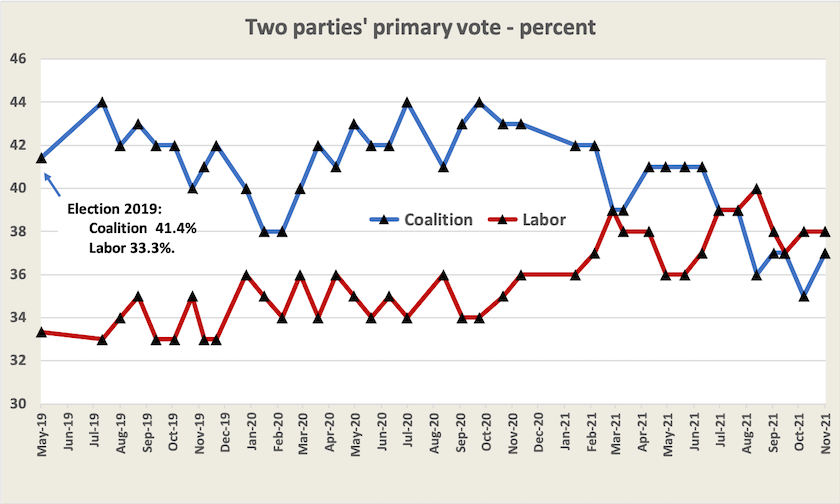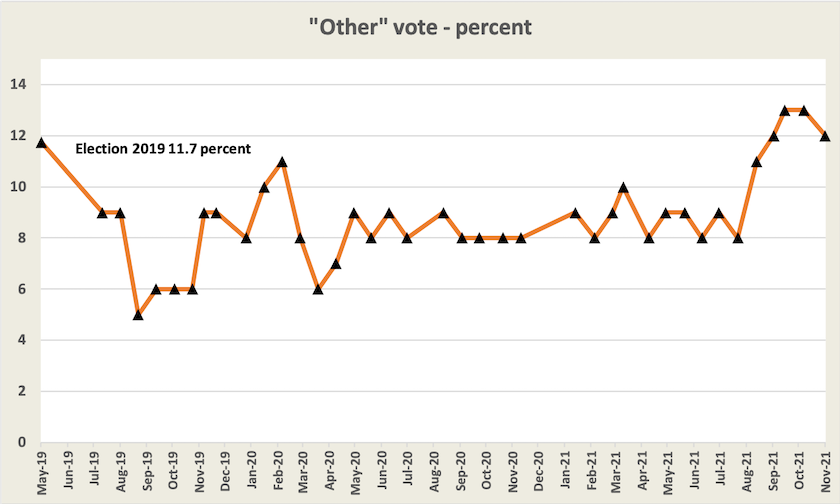Polls and surveys
Poll Bludger – a Newspoll with three findings
William Bowe’s Poll Bludger reports on the latest Newspoll.
Its headline finding is that Labor maintains its strong two-party lead, but two-party calculations are subject to many assumptions and accumulated sampling error. Nevertheless there are three more robust revelations in the poll.
First, from around this time last year, there has been a slide in support for the Coalition and a gain in support for Labor, but Labor’s gain is more modest than the Coalition’s loss. This is shown in the graph below.

Second, there is confirmation that Morrison’s net approval (approval – disapproval), which held up for so long, is now firmly negative.
The third finding from a succession of Newspolls is that in recent months there has been a significant jump in the “other” vote – other than Coalition, Labor, Green or One Nation. One interpretation of the graph below is that support for “others” has simply returned to the level they enjoyed in the 2019 election, but it is probably much higher: national polls tend to have a bias against minor parties and independents because they are not named by the pollsters.

Crispin Hull has had a look at where these “other” votes may be heading. Both main parties may lose seats, but for reasons to do with the rural-urban distribution of marginal seats, and the difficulty far-right parties will face in manning polling booths, the Coalition probably has more to lose than Labor: Preference system hurting Coalition. He also points out that in five out of six states, the Coalition will be defending three Senate seats. That’s a tough challenge. (Theoretically, in a straightforward contest, a party would need 43 percent of the vote to secure three Senate seats.)
Bowe also reports on other polls – a Resolve Strategic poll that suggests the Coalition has a slight two-party lead, and a Morgan poll thst suggests Labor has a 55.5:44.5 two-party lead. His Bludger Track suggests the two-party position is solidifying at around 53:47 in Labor’s favour.
The general patterh from polls is that while the Coalition is losing ground, it is not all in Labor's favour. Other parties and independents are picking up support. In this situation we shouldn’t make too many predictions about preference flows: the two-party estimate is subject to many assumptions and sampling errors.
Victoria – not much support for the anti-Andrews demonstrators
William Bowe reports on a Newspoll that gives the Andrews government a 58:42 two-party lead, about the same as it had in its 2018 landslide election win. Labor is on 44 percent, the Coalition is on 36 percent, and the Greens are on 11 percent.
Even if the poll has a bias towards the government because of sampling error or some methodological shortcoming, such a bias would be insufficient to dent the finding that the Andrews government enjoys strong support for the way it has handled the pandemic. The anti-Andrews demonstrators certailny do not represent majority opinion.
Although this is a state poll, federal politicians would surely be paying attention to it. Morrison's dog-whistled support to anti-vaxxers may win him some votes directly or through preferences, but it could cost him support among those who appreciate the seriousness of leaving a large percentage of the population unvaccinated, and among those who are not fooled by that misleading “80 percent” figure.
Essential – we want decisive action on climate change by 2030
Essential has re-designed its website. It is much easier to navigate, and has graphical displays with choices for disaggregation – by age, voting intention and gender.
For the first time, on the general question “which party do trust most to manage the economy generally?”, Labor and the Coalition are level pegging, and on the question “which party do you trust most to manage the economy in the interests of everyday Australians?” Labor is well ahead of the Coalition.
On climate change there is a clear majority seeking strong action by 2030.